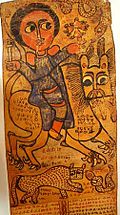Nine Saints
| Part of a series on |
| Oriental Orthodoxy |
|---|
 |
| Oriental Orthodox churches |
|
|
The Nine Saints were a group of missionaries who were important in the initial growth of Christianity in what is now Ethiopia during the late 5th century. The names of the Nine Saints are:
- Abba Aftse
- Abba Alef
- Abba Aragawi
- Abba Garima (Isaac or Yeshaq)
- Abba Guba
- Abba Liqanos
- Abba Pantelewon
- Abba Tsahma
- Abba Yem'ata
Rugare Rukuni and Erna Oliver identify the Nine Saints as Jewish Christians, and attribute the Judaic character of Ethiopian Christianity, in part, to their influence.[1]: 6, 8
Origins
Although frequently described as coming from Syria, only two or three actually came from that province; according to Paul B. Henze, others have been traced to Constantinople, Anatolia, and even Rome.[2]
The Ethiopian historian Taddesse Tamrat speculates that they may have been connected with the anti-Monophysite and anti-Miaphysite persecutions that followed the Council of Chalcedon, which adopted Dyophysitism. Their activities spread Christianity beyond "a narrow corridor between Adulis and Aksum along the caravan routes."[3]
Founding of monasteries
Besides converting the local inhabitants to Christianity, they also founded a number of monastic houses that followed the rule of Saint Pachomius: Abba Aftse founded the monastery at Yeha; Abba Alef the northernmost establishment at Bi'isa on the south bank of the Mareb River; the foundation of the important monastery of Debre Damo is attributed to Abba Aragawi; Abba Liqanos and Abba Pantelewon are credited with establishing Pentalewon Monastery in Axum; Abba Garima founded Abba Garima Monastery north of Adwa; Abba Guba the one at Madara; Abba Tsahma the one at Sedenya; and Abba Yem'ata founded the southernmost one of the group in the Gar'alta, noted for its Abuna Yemata Guh church named after him.[4]

Abba Garima and the Garima Gospels
Recent radiocarbon dating supports the tradition of Saint Abba Garima's arrival at the Abba Garima Monastery in 494.[5] The Garima Gospels, which Garima is said to have written, is now regarded as "the world's earliest illustrated Christian manuscript" and the oldest surviving Ethiopian manuscript of any kind.[5]
See also
References
- ^ Rukuni, Rugare; Oliver, Erna (January 2019). "Ethiopian Christianity: A continuum of African Early Christian polities". Hervormde Teologiese Studies. 75 (1): 1–9. doi:10.4102/hts.v75i1.5335.
- ^ Henze, Layers of Time: A History of Ethiopia (New York: Palgrave, 2000) p. 38.
- ^ Taddesse Tamrat, Church and State in Ethiopia, 1270-1527 (Oxford: Clarendon Press, 1972 ISBN 0-19-821671-8), p. 23.
- ^ This list is from Richard Pankhurst, The Ethiopians, A history (Oxford: Blackwell, 2001), p. 37 n. 38
- ^ a b Martin Bailey. "Discovery of earliest illuminated manuscript". "?". June 2010. Archived from the original on 2012-05-01.

